Panasonic CF-19 User Manual
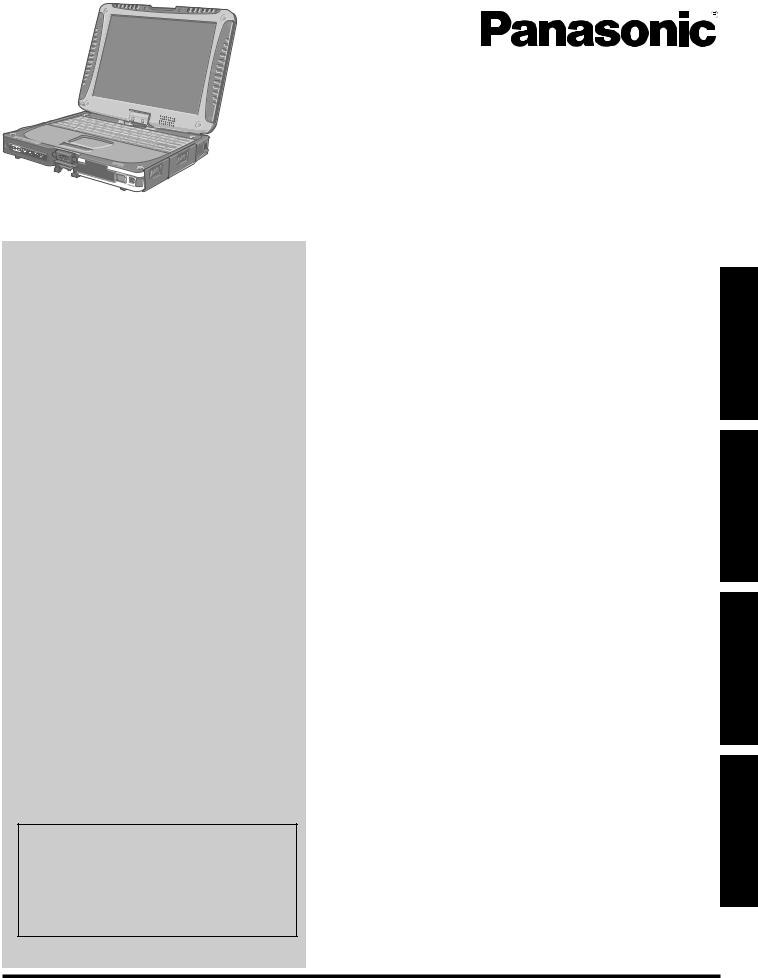
OPERATING INSTRUCTIONS
Personal Computer
Model No. CF-19 series
Contents |
|
Getting Started |
|
Introduction................................................................. |
2 |
Read Me First............................................................. |
3 |
Description of Parts .................................................. |
10 |
First-time Operation.................................................. |
13 |
Useful Information |
|
On-screen Manual.................................................... |
16 |
Handling and Maintenance....................................... |
17 |
Hard Disk Backup Function (Recover Pro) .............. |
19 |
Hard Disk Data Erase Utility..................................... |
21 |
Reinstalling Software................................................ |
22 |
Useful Information Getting Started
Troubleshooting |
|
Error Code/Message ................................................ |
24 |
Troubleshooting (Basic)............................................ |
25 |
Hardware Diagnostics .............................................. |
29 |
Troubleshooting
For further information about the computer, you can refer to the on-screen manual.
To access the on-screen manual Î page 16 “On-screen Manual”
Appendix |
|
LIMITED USE LICENSE AGREEMENT................... |
32 |
Specifications ........................................................... |
34 |
LIMITED WARRANTY.............................................. |
36 |
Appendix
Please read these instructions carefully before using this product and save this manual for future use.
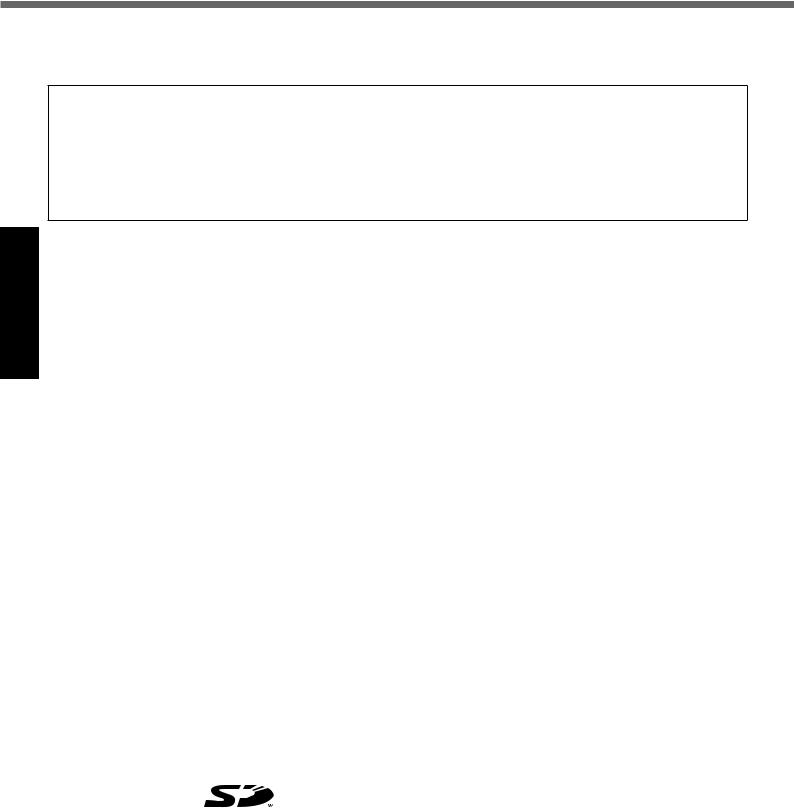
Introduction
Getting Started
Thank you for purchasing this Panasonic computer. For optimum performance and safety, please read these instruc tions carefully.
Terms and illustrations in these instructions
CAUTION |
|
: |
Conditions that may result in minor or moderate injury. |
|||
|
: |
|
|
Useful and helpful information. |
||
NOTE |
|
|
||||
|
|
: |
|
|
Press [Enter] key. |
|
Enter |
|
|
||||
|
+ F5 |
: |
|
Press and hold [Fn] key, and then press [F5] key. |
||
Fn |
||||||
[start] - [Run] : |
Click [start], and then click [Run]. You may need to double-click in some cases. |
|||||
:Page in these Operating Instructions or in the Reference Manual.
 : Reference to the on-screen manuals.
: Reference to the on-screen manuals.
zSome illustrations are simplified to help your understanding and may look different from the actual unit.
zIf you do not log on as an administrator, you cannot use some functions or cannot display some screens.
zRefer for the latest information about optional products to the catalogs, etc.
zIn these instructions, the names and terms are referred as follows.
“Microsoft® Windows® XP Professional Service Pack 2 with Advanced Security Technologies” as “Windows”, “Win dows XP” or “Windows XP Professional”
“Microsoft® Windows® XP Tablet PC Edition 2005” as “Windows”, “Windows XP” or “Windows XP Tablet PC Edi tion”
yDVD-ROM & CD-R/RW drive, and DVD MULTI drive as “CD/DVD drive”
yCircular media including DVD-ROM and CD-ROM as “discs”
zThe display modes are referred as follows. ( ) indicates the terms in [Intel® Graphics Media Accelerator Driver for Mobile] screen. To display the screen, click [start] - [Control Panel] - [Other Control Panel Options] - [Intel(R) GMA Driver for Mobile].
y Internal LCD (Notebook): The computer’s display
y External display (Monitor): External display
y Simultaneous display (Intel® Dual Display Clone): The same screen is displayed on the internal LCD and the ex
ternal display.
y Extended desktop: The extended working area across the internal LCD and the external display.
Copyright
This manual is copyrighted by Matsushita Electric Industrial Co., Ltd. with all rights reserved. No part of this manual may be reproduced in any form without the prior written permission of Matsushita Electric Industrial Co., Ltd.
No patent liability is assumed with respect to the use of the information contained herein. © 2006 Matsushita Electric Industrial Co., Ltd. All Rights Reserved.
Disclaimer
Computer specifications and manuals are subject to change without notice. Matsushita Electric Industrial Co., Ltd. as sumes no liability for damage incurred directly or indirectly from errors, omissions or discrepancies between the com puter and the manuals.
Trademarks
Microsoft®, Windows®, the Windows logo and IntelliMouse are registered trademarks of Microsoft Corporation of the United States and/or other countries.
Intel, Core, Centrino and PROSet are either registered trademarks or trademarks of Intel Corporation.
SD Logo is a trademark.
Adobe, the Adobe logo and Adobe Reader are either registered trademarks or trademarks of Adobe Systems Incorporated in the United States and/or other countries.
PhoenixBIOS, Phoenix Always and Recover Pro are trademarks and/or registered trademarks of Phoenix Technologies Ltd.
Bluetooth™ is a trademark owned by Bluetooth SIG, Inc., U.S.A. and licensed to Matsushita Electric Industrial Co., Ltd. Panasonic® is a registered trademark of Matsushita Electric Industrial Co., Ltd.
Names of products, brands, etc., appearing in this manual are trademarks or registered trademarks of their respective own companies.
2
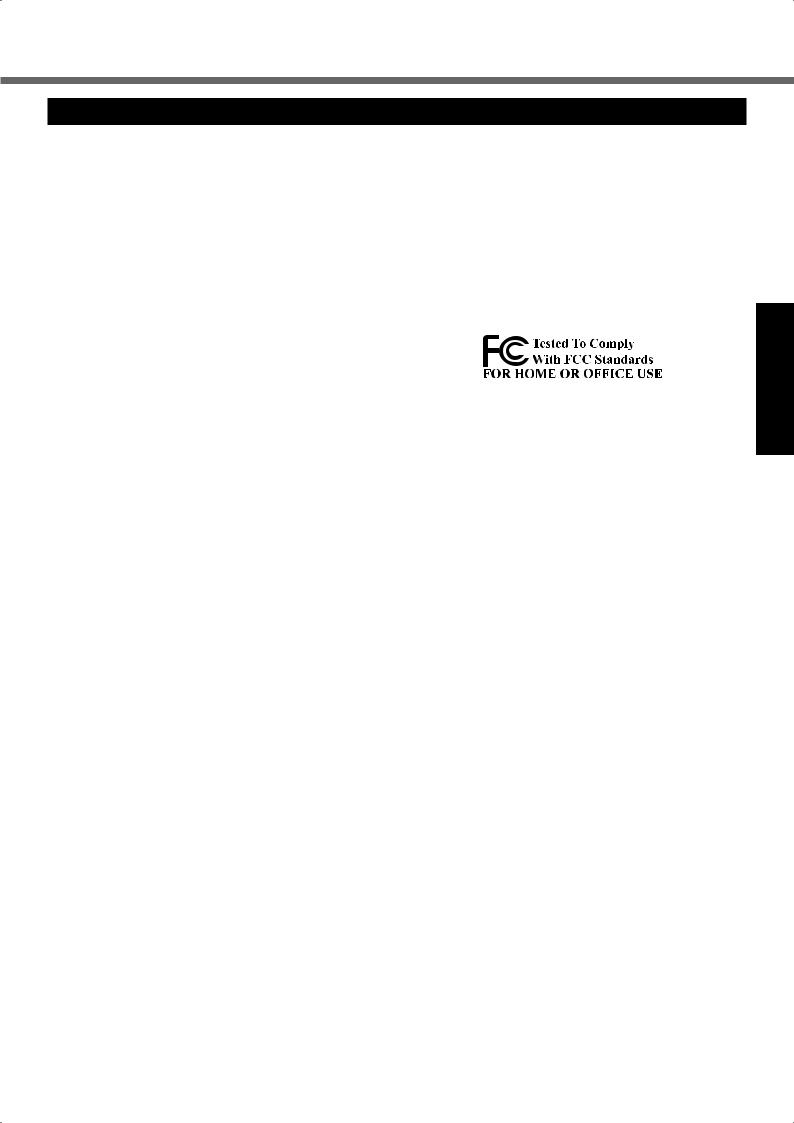
Read Me First
Models for U.S.A.
Federal Communications Commission Radio Frequency Interference Statement
Note: This equipment has been tested and found to comply with the limits for a Class B digital device, pursuant to Part 15 of the FCC Rules. These limits are designed to provide reasonable protection against harmful interference in a residential installation. This equipment generates, uses and can radiate radio frequency energy and, if not installed and used in accordance with the instructions, may cause harmful interference to radio communications. However, there is no guarantee that interference will not occur in a particular installation. If this equipment does cause harmful interference to radio or television reception, which can be determined by turning the equipment off and on, the user is encouraged to try to correct the interference by one or more of the following measures:
zReorient or relocate the receiving antenna.
zIncrease the separation between the equipment and receiver.
zConnect the equipment into an outlet on a circuit different from that to which the receiver is connected.
zConsult the Panasonic Service Center or an experienced radio/TV technician for help.
Warning
To assure continued compliance, use only shielded interface cables when connecting to a computer or peripheral. Also, any changes or modifications not expressly approved by the party responsible for compliance could void the user’s authority to operate this equipment.
FCC RF Exposure Warning:
zThis equipment is provided with PC Card slot that could be used with wireless transmitters, which will be specifically recommended when they become available.
Other third-party wireless transmitters have not been RF exposure evaluated for use with this computer and may not comply with FCC RF exposure requirements.
<Only for model with wireless LAN/Bluetooth>
zThis equipment complies with FCC radiation exposure limits set forth for an uncontrolled environment.
zThis equipment has been approved for portable operation, and unless otherwise advised in separate supplemental instructions for individual wireless transmitter(s), requires minimum 1.5 cm spacing be provided between antenna(s) and all person’s body (excluding extremities of hands, wrist and feet) during wireless modes of operation.
zThis equipment may use multiple installed transmitters, which may be capable of simultaneous transmission.
zThis equipment is provided with external antenna connector(s) for connection to optional Car Mounter or Port Replicator for mobile external mounted antenna(s). External antenna(s) must be professionally installed and cannot exceed recommended maximum antenna gain as described in individual provided supplement instructions for wireless transmitters. Also, user must maintain minimum 20 cm spacing between external antenna(s) and all person’s body (excluding extremities of hands, wrist and feet) during wireless modes of operation.
This device complies with Part 15 of the FCC Rules. Operation is subject to the following two conditions:
(1)This device may not cause harmful interference, and
(2)This device must accept any interference received, including interference that may cause undesired op-
eration.
Responsible Party: Panasonic Corporation of North America
One Panasonic Way
Secaucus, NJ 07094
Tel No:1-800-LAPTOP5 (1-800-527-8675)
6-M-1
FCC Regulation Notice for modem
This equipment contains a FCC approved modem.
1.This equipment complies with CFR47 Part 68 rules. On the computer is a label that contains, among other information, the FCC registration number and ringer equivalence number (REN) for this equipment. If required, this information must be provided to the telephone company.
2.An FCC compliant telephone cord and modular plug is provided with this equipment. This equipment is designed to be connected to the telephone network or premises wiring using a compatible modular jack which is Part 68 compliant. See Installation Instructions for details.
3.The REN is used to determine the quantity of devices which may be connected to the telephone line. Excessive RENs on the telephone line may result in the devices not ringing in response to an incoming call. In most, but not all area, the sum of RENs should not exceed five (5.0). To be certain of the number of devices that may be connected to a line, as determined by the total RENs, contact the local telephone company.
4.If your telephone equipment cause harm to the telephone network, the telephone company will notify you in advice that temporary discontinuance of service may be required. But if advice notice isn’t practical, the telephone company will notify the customer as soon as possible. Also, you will be advised of your right to file a complaint with the FCC if you believe it is necessary.
5.The telephone company may take changes in its facilities, equipment, operations or procedures that could affect the operation of the equipment. If this happens the telephone company will provide advance notice
in order for you to make necessary modifications to maintain uninterrupted service.
6.If trouble is experienced with this equipment, for repair or warranty information, please contact Panasonic Corporation of North America at DIAL TOLL FREE 1-800-LAPTOP5 (1-800-527-8675). If the equipment is causing harm to the telephone network, the telephone company may request that you disconnect the equipment until the problem is resolved.
7.There are no user serviceable parts contained in this equipment.
8.This equipment may not be used on coin service provided by the telephone company. Connection to party lines is subject to state tariffs.
Getting Started
3

Read Me First
Getting Started
9.The Telephone Consumer Protection Act of 1991 makes it unlawful for any person to use a computer or other electronic device to send any message via a telephone fax machine unless such message clearly contains in a margin at the top or bottom of each transmitted page or on the first page of the transmission, the date and time it is sent and an identification of the business or other entry, or other individual sending the message and
the telephone number of the sending machine or such business, other entity, or individual. In order to program this information into your fax software, you should refer
to the manual of the Fax software being used. 10.According to the FCC’s electrical safety advisory, we
recommend that you may install an AC surge arrestor in the AC outlet to which this equipment is connected. Telephone companies report that electrical surges, typically lightning transients, are very destructive to customer terminal equipment connected to AC power sources and that this is a major nationwide problem.
“Caution : To reduce the risk of fire, use only No.26 AWG or larger telecommunication line cord.”
“ATTENTION : Pour réduire le risque d’incendie, utiliser uniquement des conducteurs de télécommunications 26 AWG ou de section supérieure.”
16-M-1
Notice for the products using LCD
This product has a fluorescent lamp that contains mercury. Disposal may be regulated in your community due to environmental considerations.
For disposal or recycling information, please contact your local authorities, or the Electronic Industries Alliance:
<http://www.eiae.org/> |
24-M-2 |
Models for Canada
Industry Canada (IC) Notice for modem
This equipment contains an Industry Canada approved modem unit.
The Industry Canada label is affixed on the modem unit.
EQUIPMENT ATTACHEMENT LIMITATIONS
“NOTICE: The Industry Canada label identifies certified equipment. This certification means that the equipment meets telecommunications network protective, operational and safety requirements as prescribed in the appropriate Terminal Equipment Technical Requirements document(s). The Department does not guarantee the equipment will operate to the user’s satisfaction.
Before installing this equipment, users should ensure that it is permissible to be connected to the facilities of the local telecommunications company. The equipment must also be installed using an acceptable method of connection. The customer should be aware that compliance with the above conditions may not prevent degradation of service in some situations.
Repairs to certified equipment should be coordinated by a representative designated by the supplier. Any repairs or alterations made by the user to this equipment, or equipment malfunctions, may give the telecommunications company cause to request the user to disconnect the equipment. Users should ensure for their own protection that the electrical ground connections of the power utility, telephone lines and internal metallic water pipe system, if present, are connected together. This precaution may be particularly important in rural areas. Caution: Users should not attempt to make such connections themselves, but should contact the appropriate electric inspection authority, or electrician, as appropriate.”
“NOTICE: The Ringer Equivalence Number (REN) assigned to each terminal device provides an indication of the maximum number of terminals allowed to be connected to a telephone interface. The termination on an interface may consist of any combination of devices subject only to the requirement that the sum of the Ringer Equivalence Numbers of all the devices does not exceed 5.”
REN: See bottom of the computer
RESTRICTIONS CONCERNANT LE RACCORDEMENT DE MATÉRIEL
“AVIS: L’étiquette d’Industrie Canada identifie le matériel homologué. Cette étiquette certifie que le matériel est conforme aux normes de protection, d’exploitation et de sécurité des réseaux de télécommunications, comme
le prescrivent les documents concernant les exigences techniques relatives au matériel terminal. Le Ministère n’assure toutefois pas que le matériel fonctionnera à la satisfaction de l’utilisateur.
Avant d’installer ce matériel, l’utilisateur doit s’assurer qu’il est permis de le raccorder aux installations de l’entreprise locale de télécommunication. Le matériel doit également être installé en suivant une méthode acceptée de raccordement.
L’abonné ne doit pas oublier qu’il est possible que la conformité aux conditions énoncées ci-dessus n’empêche pas la dégradation du service dans certaines situations. Les réparations de matériel homologué doivent être coordonnées par un représentant désigné par le fournisseur. L’entreprise de télécommunications peut demander à l’utilisateur de débrancher un appareil à la suite de réparations ou de modifications effectuées par l’utilisateur ou à cause de mauvais fonctionnement.
Pour sa propre protection, l’utilisateur doit s’assurer que tous les fils de mise à la terre de la source d’énergie électrique, des lignes téléphoniques et des canalisations d’eau métalliques, s’il y en a, sont raccordés ensemble. Cette précaution est particulièrement importante dans les régions rurales. Avertissement: L’utilisateur ne doit pas tenter de faire ces raccordements lui-même; il doit avoir recours à un service d’inspection des installations électriques, ou à un électricien, selon le cas.”
“AVIS: L’indice d’équivalence de la sonnerie (IES) assigné à chaque dispositif terminal indique le nombre maximal de terminaux qui peuvent être raccordés à une interface. La terminaison d’une interface téléphonique peut consister en une combinaison de quelques dispositifs, à la seule condition que la somme d’indices d’équivalence de la sonnerie de touts les dispositifs n’excède pas 5.”
IES: Voir sous le fond de l’ordinateur
17-Ca-1
4
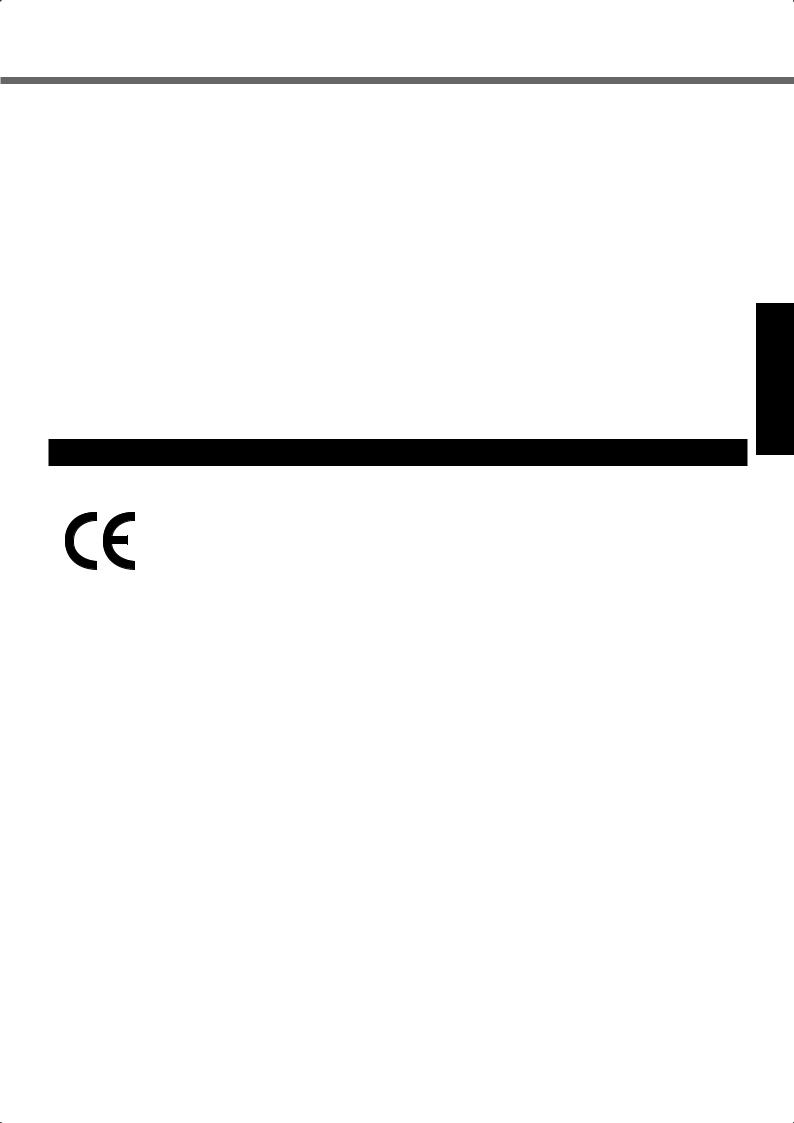
Canadian ICES-003
This Class B digital apparatus complies with Canadian ICES-003.
Cet appareil numérique de la classe B est conforme à la norme NMB-003 du Canada.
7-M-1
<Only for model with wireless LAN/Bluetooth>
Industry Canada
This product complies with RSS210 Industry Canada. Operation is subject to the following two conditions;
(1)this device may not cause interference, and
(2)this device must accept any interference, including interference that may cause undesired operation of the device.
30-Ca-1-1
<Only for model with wireless LAN>
This product (local network devices) for the band 5150-5250 MHz is only indoor usage to reduce potential for harmful interference to co-channel Mobile Satellite systems.
High power radars are allocated as primary users (meaning they have priority) of 5250-5350 MHz and 5650-5850 MHz and these radars could cause interference and/or damage to LELAN devices.
30-Ca-2-1
This device has been designed to operate with an antenna having a maximum gain of 2.15 dB. Antenna having a higher gain is strictly prohibited per regulations of Industry Canada. The Required antenna impedance is 50 ohms.
To reduce potential radio interference to other users, the antenna type and its gain should be so chosen that the equivalent isotropically radiated power (EIRP) is not more than that required for successful communication.
25-Ca-1-1
Models for Europe
<Only for model with a “CE” mark on the bottom of the computer> Declaration of Conformity (DoC)
“Hereby, we declare that this Personal Computer is in compliance with the essential requirements and other relevant provisions of the Directive 1999/5/EC.”
Hint:
If you want to get a copy of the original DoC of our products which relates to the R&TTE, please contact our web address: http://www.doc.panasonic.de
Contact:
Panasonic Services Europe
A Division of Panasonic Marketing Europe GmbH Panasonic Testing Centre
Network connection.
The terminal equipment is intended for connection to the following public network; In all the countries of European Economical Area;
- Public Switched Telephony Networks
Technical Features.
The terminal equipment includes the following features;
-DTMF dialing
-Maximum bitrate receiving mode: 56 kbit/s
-Maximum bitrate sending mode: 33.6 kbit/s
This product is designed to interwork with the Public Switched Telecommunication Networks in UK, Ireland, Netherlands, Sweden, Denmark, Finland, Switzerland, Luxembourg, Belgium, France, Germany, Spain, Portugal, Iceland, Greece, Italy, Norway and Austria.
18-E-1
Getting Started
5

Read Me First
Getting Started
Important Safety Instructions / Importantes Mesures De Sécurité
When using your telephone equipment, basic safety precautions should always be followed to reduce the risk of fire, electric shock and injury to persons, including the following:
1.Do not use this product near water, for example, near a bath tub, wash bowl, kitchen sink or laundry tub, in a wet basement or near a swimming pool.
2.Avoid using a telephone (other than a cordless type) during an electrical storm. There may be a remote risk of electric shock from lightning.
3.Do not use the telephone to report a gas leak in the vicinity of the leak.
4.Use only the power cord and batteries indicated in this manual. Do not dispose of batteries in a fire. They may explode. Check with local codes for possible special disposal instructions.
SAVE THESE INSTRUCTIONS
19-E-1
Certaines mesures de sécurité doivent être prises pen dant l’utilisation de matérial téléphonique afin de réduire les risques d’incendie, de choc électrique et de blessures. En voici quelquesunes:
1.Ne pas utiliser l’appareil près de l’eau, p.ex., près d’ une baignoire, d’un lavabo, d’un évier de cuisine, d’un bac à laver, dans un sous-sol humide ou près d’une piscine.
2.Éviter d’utiliser le téléphone (sauf s’il s’agit d’un ap pareil sans fil) pendant un orage électrique. Ceci peut présenter un risque de choc électrique causé par la foudre.
3.Ne pas utiliser l’appareil téléphonique pour signaler une fuite de gaz s’il est situé près de la fuite.
4.Utiliser seulement le cordon d’alimentation et le type de piles indiqués dans ce manual. Ne pas jeter les piles dans le feu: elles peuvent exploser. Se conform er aux règlements pertinents quant à l’élimination des piles.
CONSERVER CES INSTRUCTIONS
19-F-1
Information to the User
<Only for model with wireless LAN/Bluetooth>
This product and your Health
This product, like other radio devices, emits radio fre quency electromagnetic energy. The level of energy emitted by this product however is far much less than the electromagnetic energy emitted by wireless devices like for example mobile phones.
Because this product operates within the guidelines found in radio frequency safety standards and recommenda tions, we believe this product is safe for use by consum ers. These standards and recommendations reflect the consensus of the scientific community and result from deliberations of panels and committees of scientists who continually review and interpret the extensive research literature.
In some situations or environments, the use of this prod uct may be restricted by the proprietor of the building or responsible representatives of the organization. These situations may for example include:
zUsing this product on board of airplanes, or
zIn any other environment where the risk of interference to other devices or services is perceived or identified as harmful.
If you are uncertain of the policy that applies on the use of wireless devices in a specific organization or environ ment (e.g. airports), you are encouraged to ask for autho rization to use this product prior to turning on the product.
Regulatory Information
We are not responsible for any radio or television interfer ence caused by unauthorized modification of this product. The correction of interference caused by such unauthor ized modification will be the responsibility of the user. We and its authorized resellers or distributors are not liable for damage or violation of government regulations that may arise from failing to comply with these guidelines.
26-M-1
Lithium Battery / Pile au lithium
Lithium Battery!
This computer contains a lithium battery to enable the date, time, and other data to be stored. The battery should only be exchanged by authorized service person nel.
Warning!
A risk of explosion from incorrect installation or misappli cation may possibly occur.
15-E-1
Pile au lithium!
Le micro-ordinateur renferme une pile au lithium qui permet de sauvegarder certaines données, notamment la date et l’heure. La pile ne doit être remplacée que par un technicien qualifié.
Danger ! Risque d’explosion en cas de non respect de cette mise en garde!
15-F-1
6
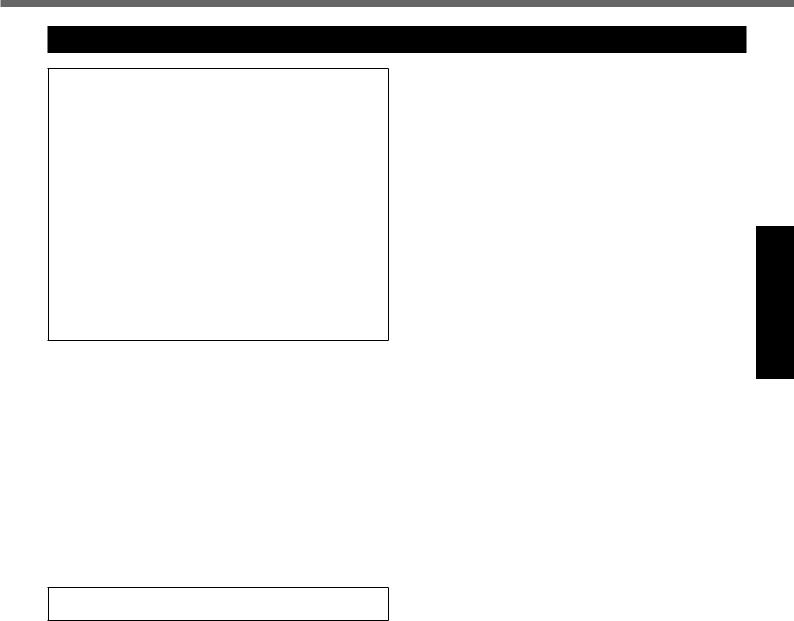
Precautions
THIS PRODUCT IS NOT INTENDED FOR USE AS, OR AS PART OF, NUCLEAR EQUIPMENT/SYSTEMS, AIR TRAF FIC CONTROL EQUIPMENT/SYSTEMS, OR AIRCRAFT COCKPIT EQUIPMENT/SYSTEMS*1. PANASONIC WILL NOT BE RESPONSIBLE FOR ANY LIABILITY RESULT ING FROM THE USE OF THIS PRODUCT ARISING OUT OF THE FOREGOING USES.
*1 AIRCRAFT COCKPIT EQUIPMENT/SYSTEMS include Class2 Electrical Flight Bag (EFB) Systems and Class1 EFB Systems when used during critical phases of flight (e.g., during take-off and landing) and/or mounted on to the aircraft. Class1 EFB Systems and 2 EFB Systems are defined by FAA: AC (Advisory Circular) 120-76A or JAA: JAA TGL (Temporary Guidance Leaflets) No.36.
Panasonic cannot guarantee any specifications, technolo gies, reliability, safety (e.g. Flammability/Smoke/Toxic ity/Radio Frequency Emission, etc) requirements related to aviation standards that exceed the specifications of our COTS (Commercial-Off-The-Shelf) products.
39-E-1
This computer is not intended for use in medical equipment including life-support systems, air traffic control systems, or other equipment, devices or systems that are involved with ensuring human life or safety. Panasonic cannot be held responsible in any way for any damages or loss resulting from the use of this computer in these types of equipment, devices or systems, etc.
The CF-19 was developed based on thorough research into the real-world portable computing environments. Exhaustive pursuit of usability and reliability under harsh conditions led to innovations such has the magnesium alloy exterior, vibra tion damped hard disk drive and floppy disk drive, flexible internal connections. The CF-19’s outstanding engineering has been tested using the strict MIL-STD- 810F (for vibration and shock) and IP (for dust and water) based procedures. As with any portable computer device precautions should be taken to avoid any damage. The following usage and han dling procedures are recommended.
Before putting the computer away, be sure to wipe off any moisture.
If a Malfunction Occurs, Immediately Unplug the AC Cord and the Battery Pack
yComputer is damaged
yForeign object inside computer Smoke emitted
yUnusual smell emitted
Unusually hot
Continuing to use the computer while any of the above con ditions are present may result in fire or electric shock.
yIf a malfunction occurs, immediately turn the power off and unplug the AC cord, and then remove the battery pack.
Do Not Touch the Computer and Cable When It Starts Thundering
Electric shock may result.
Do Not Connect the AC Adaptor to a Power Source Other Than a Standard Household AC Outlet
Otherwise, a fire due to overheating may result. Connecting to a DC/AC converter (inverter) may damage the AC adap tor. On an airplane, only connect the AC adaptor/charger to an AC outlet specifically approved for such use.
Do Not Do Anything That May Damage the AC Cord, the DC Plug, or the AC Adaptor
Do not damage or modify the cord, place it near hot tools, bend, twist, or pull it forcefully, place heavy objects on it, or bundle it tightly.
Continuing to use a damaged cord may result in fire, short circuit, or electric shock.
Do Not Pull or Insert the DC Plug If Your Hands Are Wet
Electric shock may result.
Clean the DC Plug of Dust and Other Debris Regularly
If dust or other debris accumulates on the plug, humidity, etc. may cause a defect in the insulation, which may result in a fire.
yPull the plug, and wipe it with a dry cloth.
Pull the plug if the computer is not being used for a long period of time.
Insert the AC Plug Completely
If the plug is not inserted completely, fire due to overheating or electric shock may result.
y Do not use a damaged plug or loose AC outlet.
Close the Connector Cover Tightly When Using the Computer Where Is a Lot of Water, Moisture, Steam, Dust, Oily Vapors, etc.
The entry of foreign matter may cause a fire or electric shocks.
yIf foreign matter has found its way inside, immediately turn the power off and unplug the AC cord, and then remove the battery pack. Then contact your technical support of fice.
Do Not Disassemble the Computer
There are high-voltage areas inside which may give you an electric shock if you should touch them. Do not touch the pins and circuit boards inside, and do not allow foreign mat ter to enter inside.
Also, remodeling or disassembly may cause a fire.
Keep SD Memory Cards Away from Infants and Small Children
Accidental swallowing will result in bodily injury.
In the event of accidental swallowing, see a doctor immediately.
Do Not Place the Computer on Unstable Surfaces
If balance is lost, the computer may fall over or drop, result ing in an injury.
Avoid Stacking
If balance is lost, the computer may fall over or drop, result ing in an injury.
Do Not Leave the Computer in High Temperature Envi ronment Such as in a Sun-Heated Car, for a Long Period of Time
Leaving the computer where it will be exposed to extremely high temperatures such as in a sun-heated car or in direct sunlight may deform the cabinet and/or cause trouble in the internal parts. Continued use in such a resulting condition may lead to short-circuiting or insulation defects, etc. which may in turn lead to a fire or electric shocks.
Hold the Plug When Unplugging the AC Cord
Pulling on the cord may damage the cord, resulting in a fire or electric shock.
Do Not Move the Computer While the DC Plug Is Con nected
The AC cord may be damaged, resulting in fire or electric shock.
yIf the AC cord is damaged, unplug the DC plug immedi ately.
Use Only the Specified AC Adaptor With Your Computer
Using an AC adaptor other than the one supplied (attached to your computer or supplied by Panasonic) may result in a fire.
Do Not Subject the AC Adaptor to Any Strong Impact
Using the AC adaptor after a strong impact such as being dropped may result in electric shock, short circuit, or fire.
Take a Break of 10-15 Minutes Every Hour
Using the computer for long periods of time may have detri mental health effects on the eyes or hands.
Getting Started
7

Read Me First
Getting Started
Do Not Turn the Volume Up to Loud When Using Headphones
Listening at high volumes that overstimulate the ear for long periods of time may result in loss of hearing.
Use the Modem with a Regular Telephone Line
Connection to an internal phone line (on-premise switches) of a company or business office, etc. or to a digital public phone or use in a country or area not supported by the computer may result in a fire or electric shocks.
Do Not Connect a Telephone Line, or a Network Cable Other Than the One Specified, into the LAN Port
If the LAN port is connected to a network such as the ones listed below, a fire or electric shock may result.
yNetworks other than 100BASE-TX or 10BASE-T
yPhone lines (Telephone lines, internal phone lines (onpremise switches), digital public phones, etc.)
Do Not Use with Exposing the Skin to the Computer for a Long Period of Time
Using the computer with exposing the skin to the heat source of the computer or AC adaptor for a long period of time can cause a low-temperature burn.
zDo not place the computer near a television or radio receiver.
zKeep the computer away from magnets. Data stored on the hard disk may be lost.
Precautions (Battery Pack)
Do Not Use with Any Other Computer
The battery pack is rechargeable and was intended for the specified computer. If it is used with a computer other than the one for which it was designed, electrolyte leakage, generation of heat, ignition or rupture may result.
Do Not Charge the Battery Using the Methods Other Than Those Specified
If the battery is not charged using one of the specified methods, electrolyte leakage, generation of heat, ignition or rupture may result.
Do Not Throw the Battery Pack into a Fire or Expose It to Excessive Heat
Generation of heat, ignition or rupture may result.
Avoid Extreme Heat (Near the Fire, in Direct Sunlight, for Example)
Electrolyte leakage, generation of heat, ignition or rupture may result.
Do Not Insert Sharp Objects into the Battery Pack, Expose It to Bumps or Shocks, Disassemble, or Modify It
Electrolyte leakage, generation of heat, ignition or rupture may result.
Do Not Short the Positive (+) and Negative (-) Contacts
Generation of heat, ignition or rupture may result. Do not place the battery pack together with articles such as necklaces or hairpins when carrying or storing.
Do Not Use This Computer with a Battery Pack Other Than the One Specified
Use only the specified battery pack (CF-VZSU48U) with your CF-19. Use of battery packs other than those manufactured and supplied by Panasonic may present a safety hazard (generation of heat, ignition or rupture).
zDo not touch the terminals on the battery pack. The battery pack may no longer function properly if the contacts are dirty or damaged.
zDo not expose the battery pack to water, or allow it to become wet.
zIf the battery pack will not be used for a long period of time (a month or more), charge or discharge (use) the battery pack until the remaining battery level becomes 30% to 40% and store it in a cool, dry place.
zThis computer prevents overcharging of the battery by recharging only when the remaining power is less than approx. 95% of capacity.
zThe battery pack is not charged when the computer is first purchased. Be sure to charge it before using it for the first time. When the AC adaptor is connected to the computer, charging begins automatically.
zShould the battery leak and the fluid get into your eyes, do not rub your eyes. Immediately flush your eyes with clear water and see a doctor for medical treatment as soon as possible.
NOTE
zThe battery pack may become warm during recharging or normal use. This is completely normal.
zRecharging will not commence if internal temperature of the battery pack is outside of the allowable temperature range (0 °C to 50 °C {32°F to 122 °F}).
(Î  Reference Manual “Battery Power”) Once the allowable range requirement is satisfied, charging begins automatically. Note that the recharging time varies based on the usage conditions. (Recharging takes longer than usual when the temperature is 10 ° C {50 °F} or below.)
Reference Manual “Battery Power”) Once the allowable range requirement is satisfied, charging begins automatically. Note that the recharging time varies based on the usage conditions. (Recharging takes longer than usual when the temperature is 10 ° C {50 °F} or below.)
zIf the temperature is low, the operating time is shortened. Only use the computer within the allowable temperature range.
zThis computer has a high temperature mode function that prevents the degradation of the battery in high
temperature environments. (Î  Reference Manual “Battery Power”) A level corresponding to a 100% charge for high temperature mode is approximately equivalent to an 80% charge level for normal temperature mode.
Reference Manual “Battery Power”) A level corresponding to a 100% charge for high temperature mode is approximately equivalent to an 80% charge level for normal temperature mode.
zThe battery pack is a consumable item. If the amount of time the computer can be run by using a particular battery pack becomes dramatically shorter and repeated recharging does not restore its performance, the battery pack should be replaced with a new one.
zWhen transporting a spare battery inside a package, briefcase, etc., it is recommended that it be placed in a plastic bag so that its contacts are protected.
zAlways power off the computer when it is not in use. Leaving the computer on when the AC adaptor is not connected will exhaust the remaining battery capacity.
8

For Used in Motor Vehicle /Pour L’utilisation Dans Un Véhicule Motorisé
Warning: Notebook Computer may be installed in a mo tor vehicle and visible to the driver only if used to support vehicle related functions such as vehicle information, system control, rear or side observation and navigation. If used for entertainment purpose, such as television recep tion or video play, it must be installed to the rear of the driver’s seat where it will not be
visible, directly or indirectly, to the operator of the motor vehicle. Check with individual state/provincial laws to de termine lawful use of this product while operating within a motor vehicle.
Avertissement : L’ordinateur bloc-notes peut être installé dans un véhicule motorisé et dans le champ de vision du conducteur uniquement en tant que dispositif d’aide aux fonctions du véhicule, comme par exemple pour fournir des informations sur le véhicule, comme dispositif de contrôle de système, pour l’observation à l’arrière ou sur les côtés du véhicule, ainsi que pour fournir de l’informa tion routière. Pour toute utilisation à fin de divertissement, comme par exemple pour regarder la télévision ou jouer à des jeux vidéo, il doit être installé à l’arrière du siège du conducteur, en un emplacement où il ne sera pas visible, ni directement ni indirectement, pour le conducteur du véhicule motorisé. Vérifiez les lois fédérales et nationales qui régissent l’utilisation légale de cet appareil à l’intérieur d’un véhicule motorisé.
35-M-1
Information on Disposal for Users of Waste Electrical & Electronic Equipment households)
Getting Started
Information on Disposal in other Countries outside the European Union
This symbol is only valid in the European Union.
If you wish to discard this product, please contact your local authorities or dealer and ask for the correct method of disposal.
36-M-1
9

Description of Parts
Getting Started
A:Wireless LAN Antenna
<Only for model with wireless LAN>
Î Reference Manual “Wireless LAN”
Reference Manual “Wireless LAN”
B:Bluetooth Antenna
<Only for model with Bluetooth>
Î Reference Manual “Bluetooth”
Reference Manual “Bluetooth”
C:Stylus/Pen Holder
D:Touch Pad
E:LED Indicator
 : Wireless ready
: Wireless ready
This indicator lights when Wireless LAN, Bluetooth, and/or Wireless WAN are connected and ready. It does not necessarily indicate the On/Off condition of the wireless connection.
Î Reference Manual “Wireless Switch Utility”
Reference Manual “Wireless Switch Utility”  : Wireless WAN status
: Wireless WAN status
<Only for model with wireless WAN>
Refer to the instruction manual of the wireless device.
 : Caps lock
: Caps lock
 : Numeric key (NumLk\
: Numeric key (NumLk\
 : Scroll lock (ScrLk\
: Scroll lock (ScrLk\
 : Hard disk drive status
: Hard disk drive status
F:Tablet Buttons
Î Reference Manual “Tablet Buttons”
Reference Manual “Tablet Buttons”
G:LCD
<Only for model with touchscreen>
Î Reference Manual “Touchscreen” <Only for model with digitizer>
Reference Manual “Touchscreen” <Only for model with digitizer>
Î Reference Manual “Digitizer”
Reference Manual “Digitizer”
H:Display Release Latch
page 12 “Switching to the Tablet mode”
I:Speaker
Î Reference Manual “Key Combinations”
Reference Manual “Key Combinations”
J:Function Key
Î Reference Manual “Key Combinations”
Reference Manual “Key Combinations”
K:Keyboard
L:Hard Disk Drive
Î Reference Manual “Hard Disk Drive”
Reference Manual “Hard Disk Drive”
M:Battery Pack
N:Power Switch
O:LED Indicator
 : Battery status
: Battery status
Î Reference Manual “Battery Power”  : Power status
: Power status
(Off: Power off/Hibernation, Green: Power on, Blinking green: Standby)
A lithium ion battery that is recyclable powers the product you have purchased. Please call 1-800-8-BATTERY for information on how to recycle this battery.
L’appareil que vous vous êtes procuré est alimenté par une batterie au lithium-ion. Pour des renseignements sur le recyclage de la batterie, veuillez composer le 1-800-8-BATTERY.
10

Left side
|
|
|
|
|
|
|
|
|
|
|
|
|
|
|
|
|
|
|
|
|
|
|
|
|
|
|
|
|
|
|
|
|
|
|
|
|
|
|
|
|
|
|
|
|
|
|
|
|
|
|
|
|
|
|
|
|
|
|
|
|
|
|
|
|
|
|
|
|
|
|
|
|
|
|
|
|
|
|
|
|
|
|
|
|
|
|
|
|
|
|
|
|
|
|
|
|
|
|
|
|
|
|
|
|
|
|
|
|
|
|
|
|
|
|
|
|
|
|
|
|
|
|
|
|
|
|
|
|
|
|
|
|
|
|
|
|
|
|
|
|
|
|
|
|
|
|
|
|
|
|
|
|
|
|
|
|
|
|
|
|
|
|
|
|
|
|
|
|
|
|
|
|
|
|
|
|
|
|
|
|
|
|
|
|
|
|
|
|
|
|
|
|
|
|
|
|
|
|
|
|
|
|
|
|
|
|
|
|
|
|
|
|
|
|
|
|
|
|
|
|
|
|
|
|
|
|
|
|
|
|
|
|
|
|
|
|
|
|
|
|
|
|
|
|
|
|
|
|
|
|
|
|
|
|
|
|
|
|
|
|
|
|
|
|
|
|
|
|
|
|
|
|
|
|
|
|
|
|
|
|
|
|
|
|
|
|
|
|
|
|
|
|
|
|
|
|
|
|
|
|
|
|
|
|
|
|
|
|
|
|
|
|
|
|
Rear side |
|
|
|
|
|
Bottom |
|
|
|
|
|
|
|
|||||||||||||||||||||
|
|
|
|
|
|
|
|
|
|
|
|
|||||||||||||||||||||||
Getting Started
A:DC-IN Jack
B:USB Port
Î Reference Manual “USB Devices”
Reference Manual “USB Devices”
C:IEEE 1394 Interface Connector
Î Reference Manual “IEEE 1394 Devices”
Reference Manual “IEEE 1394 Devices”
D:Modem Port
Î Reference Manual “Modem”
Reference Manual “Modem”
E:LAN Port
Î Reference Manual “LAN”
Reference Manual “LAN”
F:SD Memory Card Indicator
(Blinking: During access)
Î Reference Manual “SD Memory Card”
Reference Manual “SD Memory Card”
G:SD Memory Card Slot
Î Reference Manual “SD Memory Card”
Reference Manual “SD Memory Card”
H:Wireless Switch
Î Reference Manual “Wireless Switch Utility”
Reference Manual “Wireless Switch Utility”
I:PC Card Slot
Î Reference Manual “PC Card / ExpressCard”
Reference Manual “PC Card / ExpressCard”
J:ExpressCard Slot
Î Reference Manual “PC Card / ExpressCard”
Reference Manual “PC Card / ExpressCard”
K:Headphone Jack
You can connect headphones or amplified speakers. When they are connected, audio from the internal speakers is not heard.
L:Microphone Jack
A condenser microphone can be used. If other types of microphones are used, audio input may not be possible, or malfunctions may occur as a result.
y When recording in stereo using a stereo microphone:
Double-click in the notification area, click [Options] - [Properties], and add a check mark for [Recording], click [OK] - [Options] - [Advanced Controls] - [Advanced], remove a check mark for [Mono Microphone], and then click [Close].
yWhen using a monaural microphone with a 2-termi- nal plug:
With the settings outlined above, only audio on the left track will be recorded.
When monitoring the microphone audio using headphones, sounds on the left track cannot be heard, regardless of the above settings. This is a result of the computer’s specifications, and is not a malfunction.
M:Security Lock
A Kensington cable can be connected.
For further information, read the manual that comes with the cable.
N:External Display Port
Î Reference Manual “External Display”
Reference Manual “External Display”
O:Serial Port
P:RAM Module Slot
Î Reference Manual “RAM Module”
Reference Manual “RAM Module”
Q:Expansion Bus Connector
Î Reference Manual “Port Replicator / Car Mounter”
Reference Manual “Port Replicator / Car Mounter”
R:External Antenna Connector
11
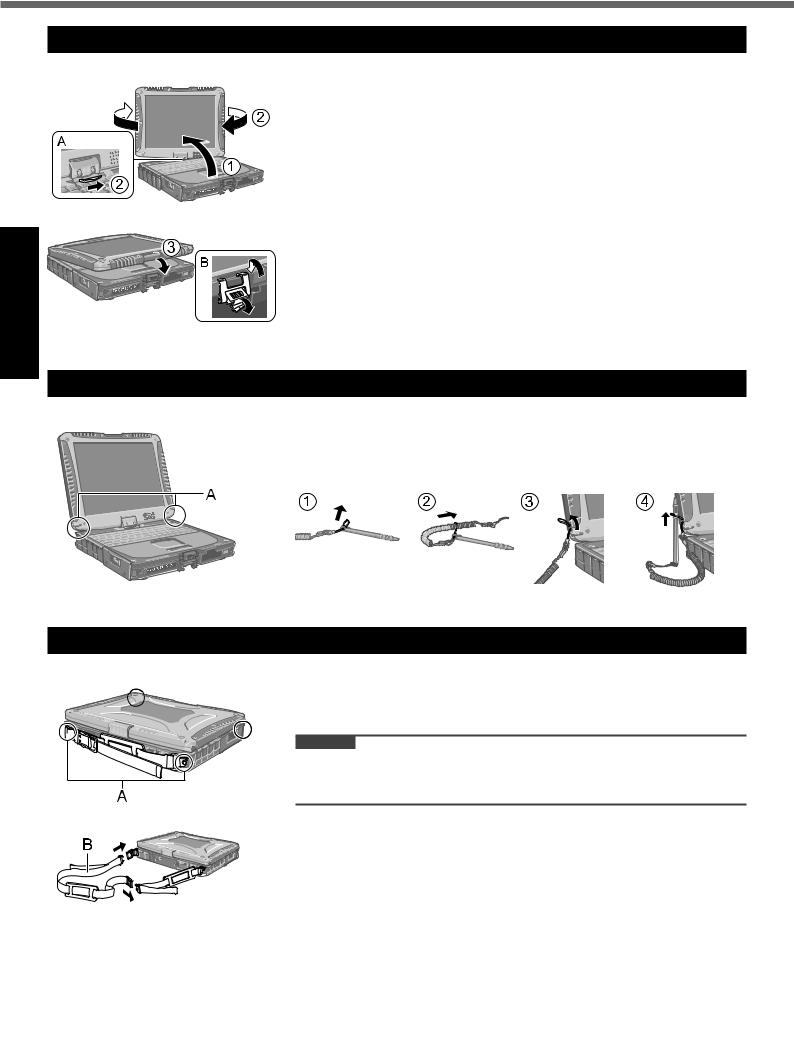
Description of Parts
Getting Started
Switching to the Tablet mode
ALift up the display so it stands perpendicular to the body.
BSlide and hold the display release latch (A), and rotate the display clockwise until it clicks.
CClose as the display faces up and fix it using the latch (B).
Attaching the stylus to the computer
Use the tether to attach the stylus to the computer so you will not lose it.
There are holes (A) to attach it.
yFor model with digitizer, the tether and pen are already attached to the computer at purchase.
Attaching the hand strap and the shoulder strap
Attach the hand strap to any two of the corners (A) using the screws. You can connect the shoulder strap (B) to the hand strap.
(The illustration is an example.)
CAUTION
z Do not use the strap to carry a heavier weight than the computer. Otherwise the strap may become loose by itself.
z Do not use the strap if it becomes worn or damaged.
12
